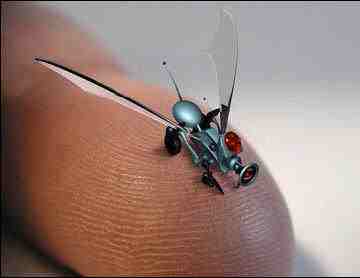Nanotechnology and Man; the not so Solid Citizen.
Nanotech creations may kill and cure
Click thumbnail to view full-size


Nanotechnology: life in a test tube?
Until fairly recently - well, let's face it, everything man does is fairly recent if you look at the big picture - we were much more interested in outer-space than the unknowable inner-space, which we had no idea existed as we know it does today. Well, perhaps the outer vastness was also unknowable in the last analysis, too, but at least we could see the moon, the sun and the other stars; even some of the other galaxies.
But until the really, really recent time, we had little idea of what constituted the molecule and the atom, much less all the other tiny bits and pieces that are coming to light daily these days. Not very long ago, thanks to Darwin, man was still coming to terms with the idea that Adam and Eve had little to do with his evolving in the universe; now he was having to accept that he was not what he appeared at all, a solid, upstanding citizen made of flesh, blood and bones, if you like.
This is because of the work involved with the very, very small particles that make up everything in our world and the universe we reside in.
A man is not really a collection of organs and all the rest held aloft by a skeleton of bones and skin. We might say he is a organization of interrelating groups of cooperating particles. These operate with the atomic and electronic energy inherent in substances which have grown together to perform for a short time, until it is the moment to join the matter (or energy) bank as we die, which is just another word for radical change. (Sorry. It’s hard to “think” this stuff, never mind put it into coherent prose). And that which we had always considered as being solid is shown to be a porous as any sieve at the sub-atomic level...tiny neutrinos and the like can pass through a brick wall - or even the planet - with impunity.
So we stand tall, all the components of our bodies - and all the other clumps of matter in the universe - held together by the mortar of the "Strong Force," that mighty attraction between quarks and other particles within the atom, which prevent us collapsing into a puddle or a pile of billions of tiny bricks.
The old argument about whether man can create life himself is as old hat in 2011 as the fairy stories about Adam and the Apple. This is mainly due to the characterization of what life really is. Once, science teachers divided this into "life," and "non-life." Animals, including us, were of course "living," while a stone, the sea, the air and the stars, etc., were "dead." At least, not alive. But as we get deeper and deeper into the study of the very small: biotechnology, computer-technology and, especially, nanotechnology, the division between what we have traditionally thought of as being alive, and the rest of the stuff in the universe, becomes very unclear indeed. In fact, at the chemical level where particles are concerned, life is determined by the action and reaction within tiny universes composed of bits of matter, some with such short lives and so small they can only be deduced mathematically, or by their cause and effect.
We know now there’s as much going on in the atoms of a lump of granite as there is in an atom of Granny’s carbuncle!
The term Nanotechnology dates back over half a century, where it was coined by Richard Feynman during a speech titled, "There's plenty of room at the bottom." Despite billions being poured into research, and top corporations becoming involved, the science is still very much in its infancy. The US government alone has spent well over one billion dollars in funding.
When we are talking nanometres (NM) we are in the realm of science fiction. One nanometre, or an NM, is one-billionth of a meter! In other words, it is to a meter what a marble is to the size of the Earth. Nanotechnology deals with materials 1 to 100 NM's in size. To work with and construct machines (etc) at this size, the tools used in fabrication have to be of the same tolerances, too. This is the realm of quantum mechanics and rarefied air indeed.
To give you another idea, the smallest bacteria know to man is 200 NM's long. And the smallest atom, that of hydrogen, is just 4 NM's in length.
To work with these building blocks of matter, scientists lay such tools as the screwdriver and pliers aside. Labs all over the world are churning-out products using nanotech. techniques, and particles have to be assembled and formed into new arrangements by manipulation with other particles and the forces that hold and divide them.
The leading edge is concerned with self-sustaining machines that can "think" for themselves and, perhaps soon, be able to self-replicate themselves, the stuff of science fiction horror movies in the past. Who was it said, "Whatever we can conceive will one day be made?" One can't help pondering if life itself is not just a dream in which the players - ourselves - actually write the scripts and move the sets.
There are huge fortunes to be made in this technology, and scientists are truly concerned that nanotechnology may run amok in the search for more and more products designed in laboratories. We engineer plant crops now, and, despite controls, some of the nano-created types have been found growing among normal types with no one knowing - or confessing - to how they got there.
Legislators seem to be on the back foot in putting legal safeguards in place to prevent atomically engineered products find a place in many applications, with little regard to man’s safety from the creations.
Top writers, such as Michael Crichton - he of Jurassic Park - has taken things a whole lot further in his terrifying and eminently believable "Prey," where some nanotech molecules designed as minute cameras develop a mind of their own and turn on their creators.
The end of the book does get a bit silly, but the lead-up and the science is exemplary writing and shows the lengths techno-fiction writers have to go to today to produce a believable scenario.
(Crichton, the reclusive, 6'9" American writer was recognized by the literary community as one of their luminous stars. He passed away in 2006 with complications from throat cancer).
We have clamped-down on hackers and their ilk who create and spread computer viruses. Many of them are, in fact, in jail as I write. Some of these clever “electronic pathogens” are seen to mutate and recreate themselves to get past our firewalls and other barriers.
It doesn’t take a huge leap of faith to imagine some clever terrorists making “real” viruses using nanotech, to invade our societies and be able to mutate to beat any medical firewalls! It’s a doomsday scenario that is, frighteningly, almost possible.
It would seem we urgently need some world-wide body with teeth to study the new inventions flooding the nanotech market. Consider the benefits; assay the risks and add a stamp of approval or its reverse.
We can but dream. As ever, big money will have its way and damn the consequencies!











